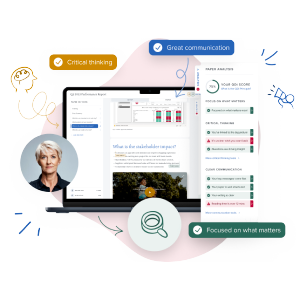For more tips on what should go in your CEO’s report, get our free guide at the end of this article.
We’ve spent years asking boards what they really want from their CEO and senior management reports — and the answer is always the same: “I want to know what’s on their mind.”
So how does that translate into a board report that’s easy to digest and easy to produce? Our tips below reflect the golden threads that we see running through the best CEO board reports.
1. Start with the end in mind
When leading the day-to-day running of an organisation, it can be hard to find time to step back and assess where you are in relation to the organisation’s goals. Preparing a report for the board should be a great opportunity for this.
Recap your organisation’s purpose and goals at the start of your report to link your update to the “big picture”. It will ensure your report focuses on what really matters and provide the board with a gentle reminder of the organisation’s mission.
“Since the last board meeting, the NEDs may have been elsewhere, working on their five or six other boards. And yet we expect them to turn up match-fit and perform out of their socks, before they disappear again. A great CEO’s report gets the board up to speed and guides directors to where the discussion should focus.”
~ Paul Drechsler CBE, Chair, London First, ICC UK
2. Discuss the bad and the good
Don’t fall into the trap of providing a good-news-only story. Everyone knows that life is not plain sailing, so board members want to hear what’s not going well as much as what is.
For a CEO report that the board trusts and values, draw out what you’re worried about and the areas where you would most welcome the board’s counsel. After all, as one non-executive director put it, “I need to read the bad news, because I need to know that they know. Without it, I can only assume that management doesn’t know their business.”
“If a mix of positives, negatives, and ‘I just don’t know’ isn’t present, I get suspicious about the nature of the information I’m getting and start wondering, ‘Why is it being presented that way, and is the pack being used in a way to manage the board rather than empower it?’”
~ Lord Victor Adebowale CBE, Chair, Visionable, NED, Nuffield Health, The Co-operative Group
3. Look forwards as well as back
Boards exist to supervise and to steer the organisation. And your CEO board report should help them do this.
Your report should look back and reflect on past performance but also spell out how you feel about the outlook and why. As another director put it, “You wouldn’t drive a car by only looking in the rear view mirror.”
Your report should draw out the implications of significant developments as well as the risks or opportunities you see ahead. No one knows your business better than you do and this insight is what the board wants to know.
“The CEO’s report is a chance to solve the problems that are troubling the chief executive, but also to lead the directors towards things they can’t easily see — such as competitors’ activity.”
~ Penny Hughes CBE, Chair, The Gym Group, Riverstone
4. Keep the KPIs in a dashboard
Narrative quickly becomes indigestible when it includes lots of numbers. A CEO report that describes performance can miss the drivers and implications of performance — or include both and become unwieldy.
The best CEO board reports sit alongside a one-page data dashboard that presents the numbers. This frees up the CEO’s narrative to focus on the overall trend and the implications of significant under—or over—performance. What’s more, a dashboard composed of the most revealing Key Performance Indicators that reflect the organisation’s primary outcomes and drivers will provide the board with a snapshot of its health — and thereby provide the board with the assurance it needs to focus on what’s on the CEO’s mind.
“I’d have every meeting begin with asking the CEO what’s keeping them awake at night — it’s the one question the board absolutely needs to address.”
~ Baroness Patience Wheatcroft, NED, St. James’s Place, Fiat
Want more advice and insight from leading chairs, directors, and chief executives on what should go in your report? Download our free Definitive Guide to the CEO’s Report.





